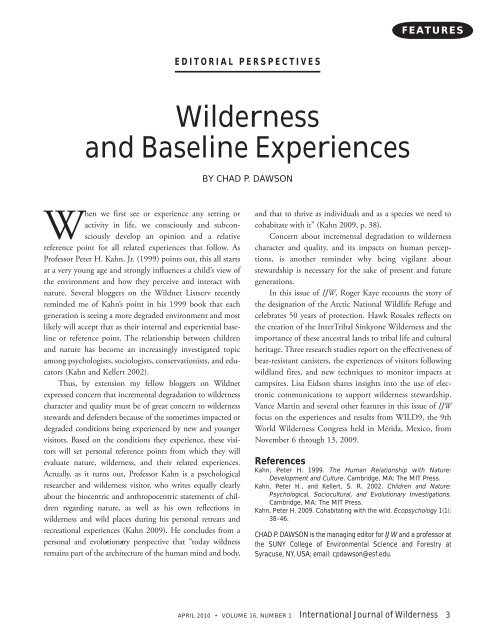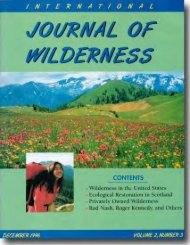Ten Tribes Reclaiming, Stewarding, and Restoring Ancestral Lands
Ten Tribes Reclaiming, Stewarding, and Restoring Ancestral Lands
Ten Tribes Reclaiming, Stewarding, and Restoring Ancestral Lands
Create successful ePaper yourself
Turn your PDF publications into a flip-book with our unique Google optimized e-Paper software.
EDITORIAL PERSPECTIVES<br />
Wilderness<br />
<strong>and</strong> Baseline Experiences<br />
When we first see or experience any setting or<br />
activity in life, we consciously <strong>and</strong> subconsciously<br />
develop an opinion <strong>and</strong> a relative<br />
reference point for all related experiences that follow. As<br />
Professor Peter H. Kahn, Jr. (1999) points out, this all starts<br />
at a very young age <strong>and</strong> strongly influences a child’s view of<br />
the environment <strong>and</strong> how they perceive <strong>and</strong> interact with<br />
nature. Several bloggers on the Wildnet Listserv recently<br />
reminded me of Kahn’s point in his 1999 book that each<br />
generation is seeing a more degraded environment <strong>and</strong> most<br />
likely will accept that as their internal <strong>and</strong> experiential baseline<br />
or reference point. The relationship between children<br />
<strong>and</strong> nature has become an increasingly investigated topic<br />
among psychologists, sociologists, conservationists, <strong>and</strong> educators<br />
(Kahn <strong>and</strong> Kellert 2002).<br />
Thus, by extension my fellow bloggers on Wildnet<br />
expressed concern that incremental degradation to wilderness<br />
character <strong>and</strong> quality must be of great concern to wilderness<br />
stewards <strong>and</strong> defenders because of the sometimes impacted or<br />
degraded conditions being experienced by new <strong>and</strong> younger<br />
visitors. Based on the conditions they experience, these visitors<br />
will set personal reference points from which they will<br />
evaluate nature, wilderness, <strong>and</strong> their related experiences.<br />
Actually, as it turns out, Professor Kahn is a psychological<br />
researcher <strong>and</strong> wilderness visitor, who writes equally clearly<br />
about the biocentric <strong>and</strong> anthropocentric statements of children<br />
regarding nature, as well as his own reflections in<br />
wilderness <strong>and</strong> wild places during his personal retreats <strong>and</strong><br />
recreational experiences (Kahn 2009). He concludes from a<br />
personal <strong>and</strong> evolutionary perspective that “today wildness<br />
remains part of the architecture of the human mind <strong>and</strong> body,<br />
BY CHAD P. DAWSON<br />
FEATURES<br />
<strong>and</strong> that to thrive as individuals <strong>and</strong> as a species we need to<br />
cohabitate with it” (Kahn 2009, p. 38).<br />
Concern about incremental degradation to wilderness<br />
character <strong>and</strong> quality, <strong>and</strong> its impacts on human perceptions,<br />
is another reminder why being vigilant about<br />
stewardship is necessary for the sake of present <strong>and</strong> future<br />
generations.<br />
In this issue of IJW, Roger Kaye recounts the story of<br />
the designation of the Arctic National Wildlife Refuge <strong>and</strong><br />
celebrates 50 years of protection. Hawk Rosales reflects on<br />
the creation of the InterTribal Sinkyone Wilderness <strong>and</strong> the<br />
importance of these ancestral l<strong>and</strong>s to tribal life <strong>and</strong> cultural<br />
heritage. Three research studies report on the effectiveness of<br />
bear-resistant canisters, the experiences of visitors following<br />
wildl<strong>and</strong> fires, <strong>and</strong> new techniques to monitor impacts at<br />
campsites. Lisa Eidson shares insights into the use of electronic<br />
communications to support wilderness stewardship.<br />
Vance Martin <strong>and</strong> several other features in this issue of IJW<br />
focus on the experiences <strong>and</strong> results from WILD9, the 9th<br />
World Wilderness Congress held in Mérida, Mexico, from<br />
November 6 through 13, 2009.<br />
References<br />
Kahn, Peter H. 1999. The Human Relationship with Nature:<br />
Development <strong>and</strong> Culture. Cambridge, MA: The MIT Press.<br />
Kahn, Peter H., <strong>and</strong> Kellert, S. R. 2002. Children <strong>and</strong> Nature:<br />
Psychological, Sociocultural, <strong>and</strong> Evolutionary Investigations.<br />
Cambridge, MA: The MIT Press.<br />
Kahn, Peter H. 2009. Cohabitating with the wild. Ecopsychology 1(1):<br />
38–46.<br />
CHAD P. DAWSON is the managing editor for IJW <strong>and</strong> a professor at<br />
the SUNY College of Environmental Science <strong>and</strong> Forestry at<br />
Syracuse, NY, USA; email: cpdawson@esf.edu.<br />
APRIL 2010 VOLUME 16, NUMBER 1 International Journal of Wilderness 3










